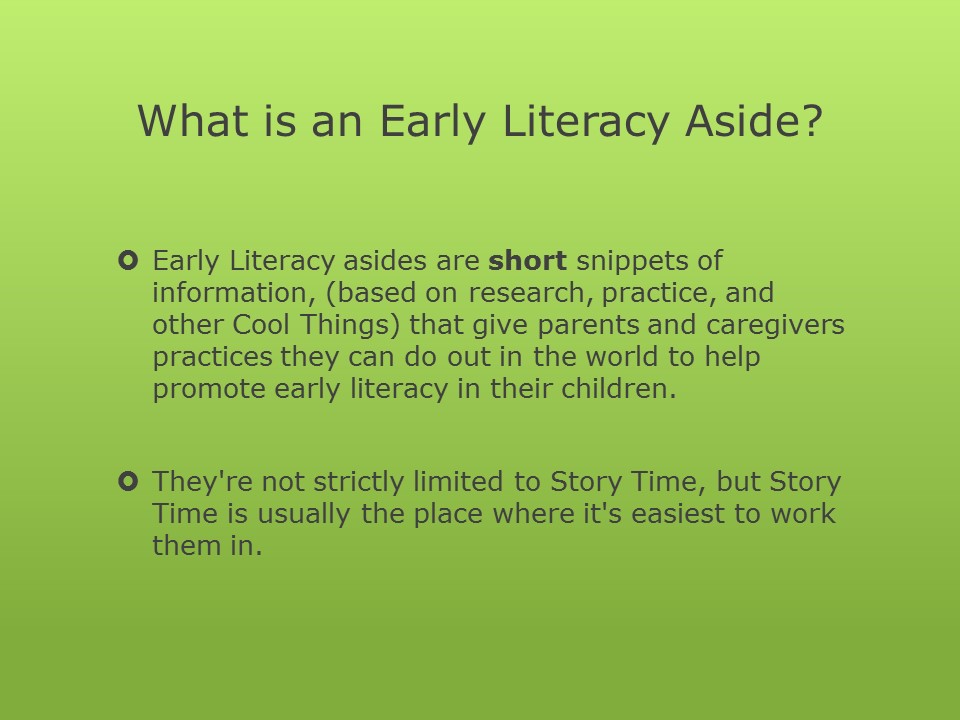
An early literacy aside is a short snippet of information, based on research, practice, or Cool Things, that gives parents and caregivers something they can do with their children that promotes the child's ability to read (or do math, or other things).
Story Time programs are the most common places where asides come out, but they're useful everywhere there are programs or practices going on in the library.
Examples, Please
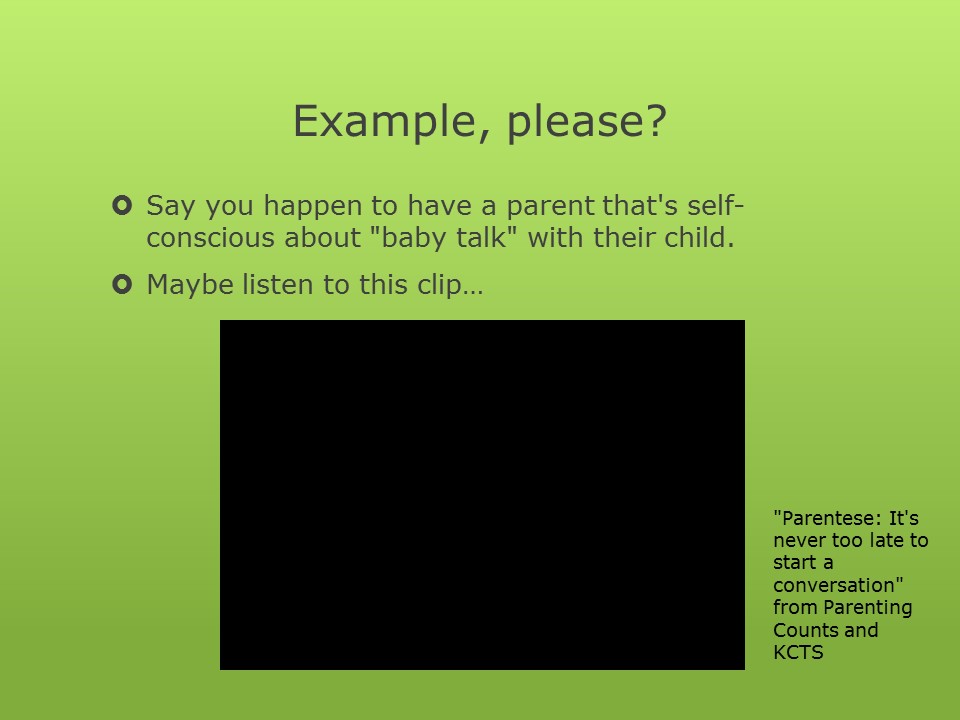
Here's an example of an early literacy moment, courtesy of Parenting Counts:
It's Never To Early To Start A Conversation

Parentese is a useful demonstration for what counts as an early literacy moment. Notice the choice of a male-appearing, football-watching caregiver as the main character who starts speaking parentese, pointing out that it's not just women who can do it. And that it happens in multiple languages, by people of all sorts of colors and body types.
If there's anything that I don't like about that video, it's that the other male-appearing people in the video are giving looks to each other like the parentese is somehow not masculine. If there were a way of throwing shade on them for it, that would be the thing to do.
The aside form of that video might be something like: "Speaking parentese to your children helps them learn the sounds of language."

There are a couple things that can make a good early literacy aside:
- Short Is Good
- Encourage the Parents
- Transition Times Are Great
- Note Literacies at Work
- Provide Reminders
If you get all of these in one aside, you're doing good. If you can get most of them, you're still doing good.
Short Is Good
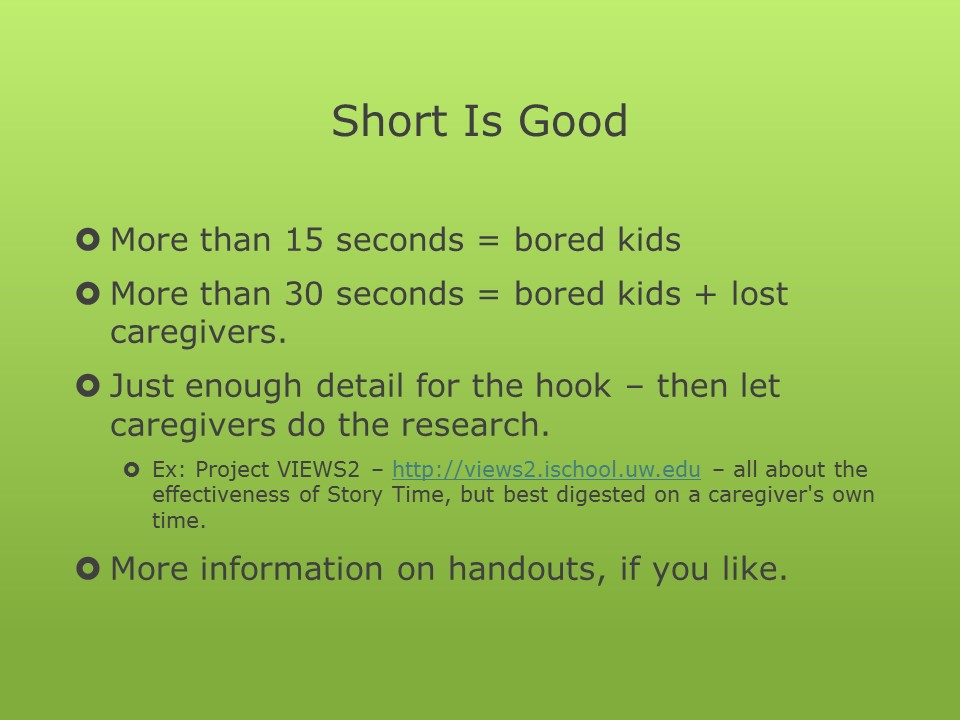
The less time you can take to deliver your message, the better.
- More than 15 seconds = bored children. This is bad.
- More than 30 seconds = bored chlidren and confused caregivers. This is worse.
Try to give enough information to get the message and a hook across. That way, the parents and caregivers can do the research behind your early literacy material on their own time, if they want.
For example, Project VIEWS2 from the iSchool at the University Washington has a lot of research and information about the effectiveness of Story Times and Youth Services practices. It's quite possible to have a deep dive off of a simple search.
If you want to provide some of that information, a handout, or the back page of a handout, is a good place to infodump.

Multnomah County Library, in Portland, Oregon, commissioned this poster with the five practices (Read, Write, Talk, Sing, Play) of early literacy. It's a great visual representation of an early literacy aside.
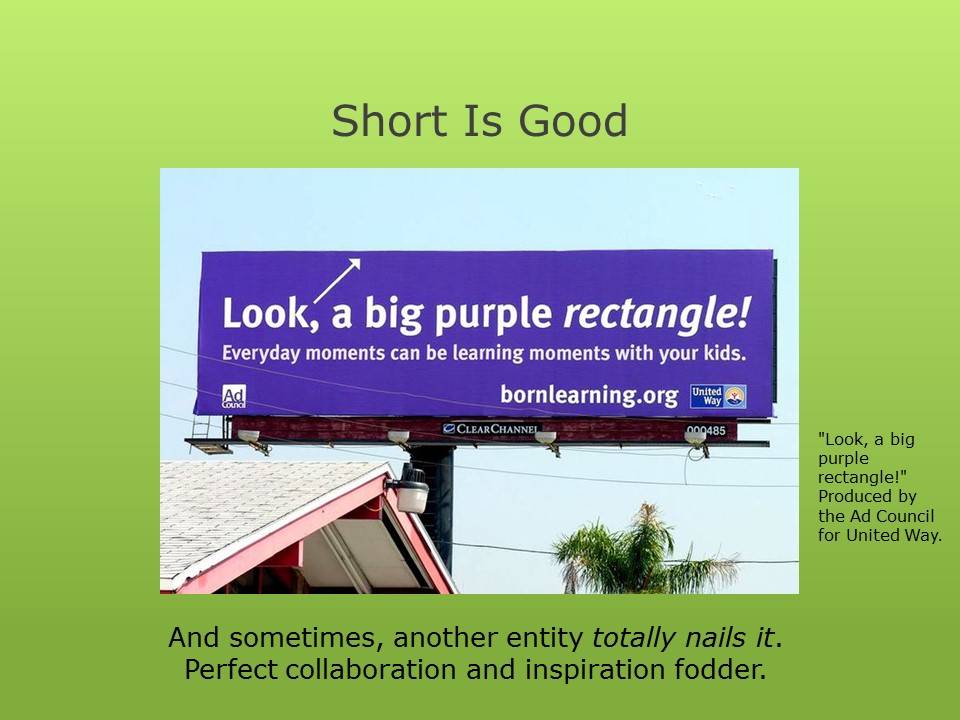
Sometimes another agency really gets it - like this outdoor advertisement, declaring "Look, a big purple rectangle!" - which is the perfect jumping-off point for an early literacy conversation in the car.
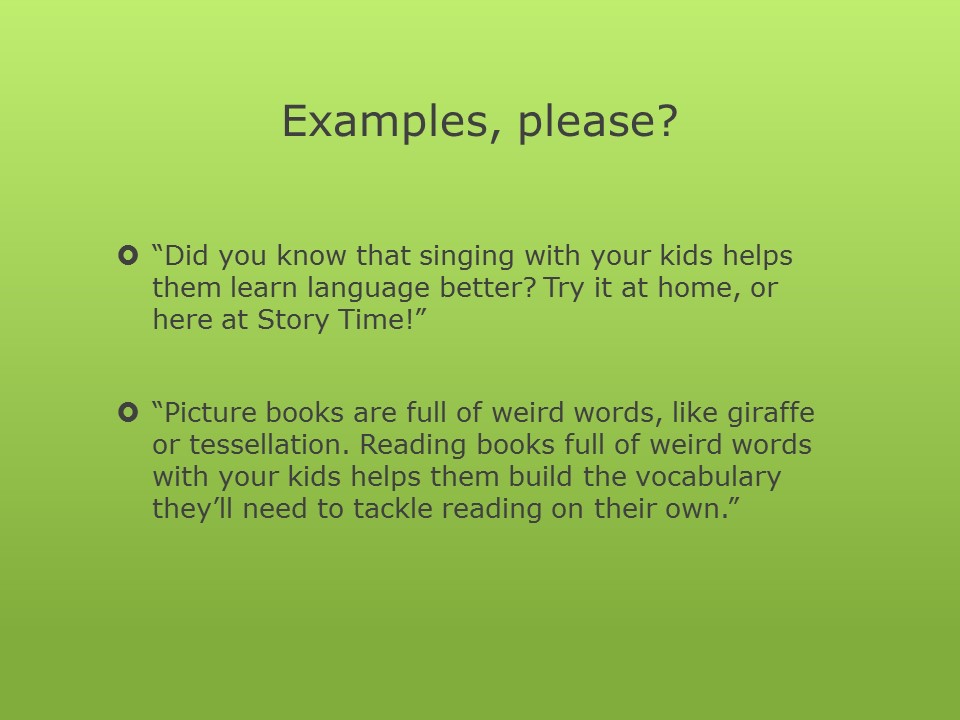
So what might this kind of aside look like?
- "Did you know that singing with your kids helps them learn language better? Try it at home, or here at Story Time!"
- "Picture books are full of weird words, like giraffe or tesselation. Reading books full of weird words with your kids helps them build the vocabulary they'll need to tackle reading on their own."
Encourage The Parents
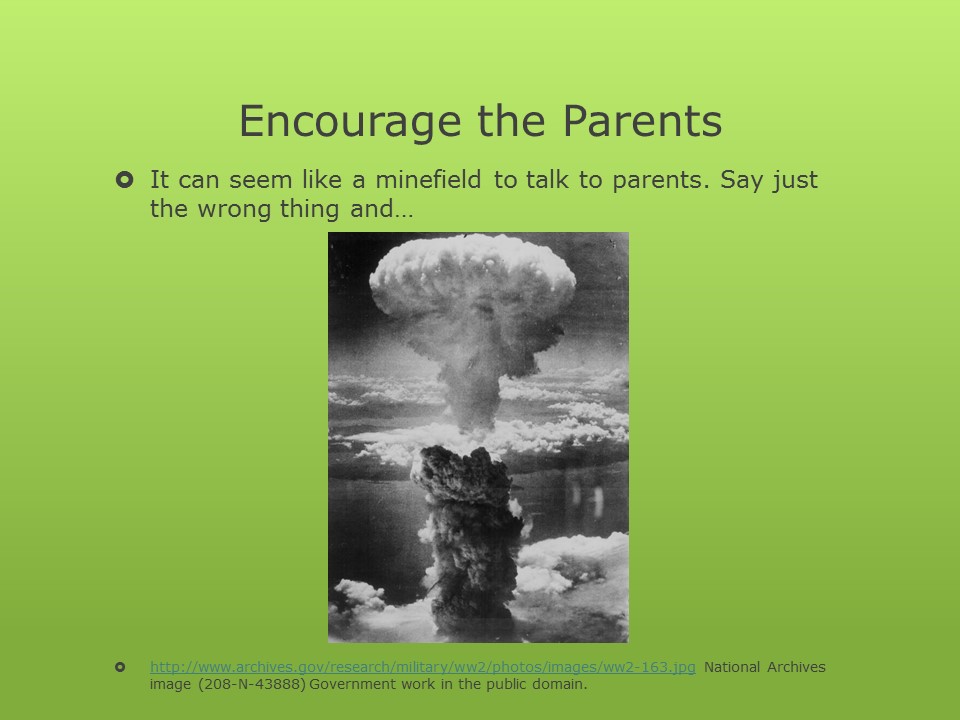
Sometimes, it can seem like suggesting anything to parents is playing with fire, or will provoke some sort of explosive reaction…
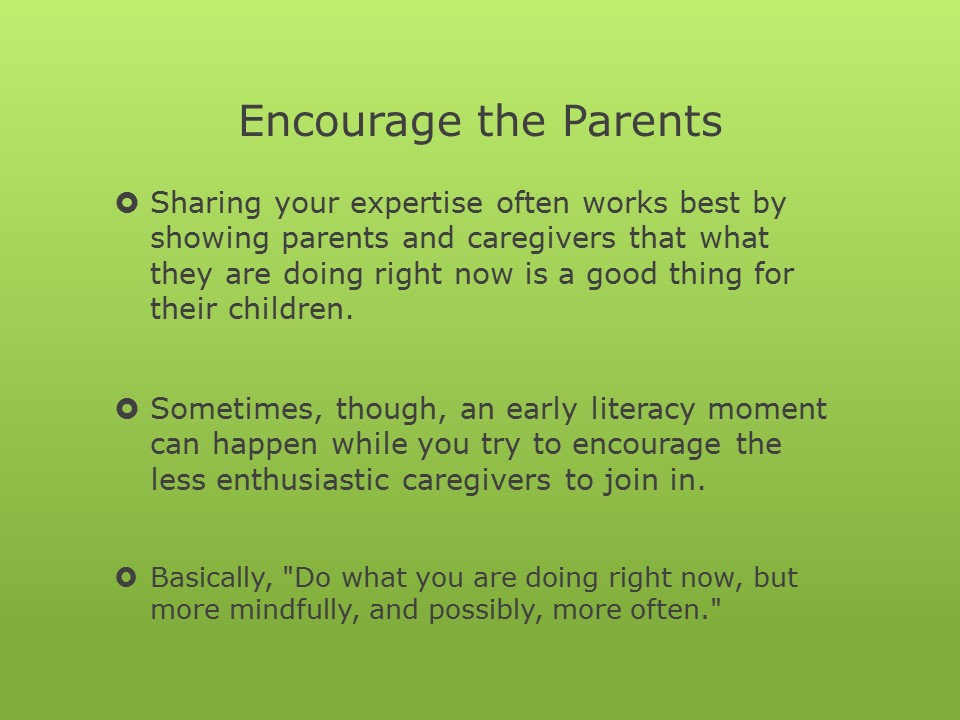
Suggestions phrased as encouragement to caregivers that what they are already doing right now will go over a lot better than others. Truthfully, what parents and caregivers are already doing is probably pretty good, in terms of getting their children ready to read. After all, they're coming to the libary already, right?
Every now and then, though, the caregivers need a little bit of a prod to participate.
What much of these practices and asides boil down to is "Do what you are already doing, but more mindfully, and possibly, more often."

Here's some examples of encouragement:
- Do you talk to your kids at home? Great! The more you do it, the quicker they learn language. The more words you use, the more words they have."
- If you speak more than one language in your family, use all your languages at home - your kids will benefit from hearing all the possible sounds they'll need to know to be able to communicate."
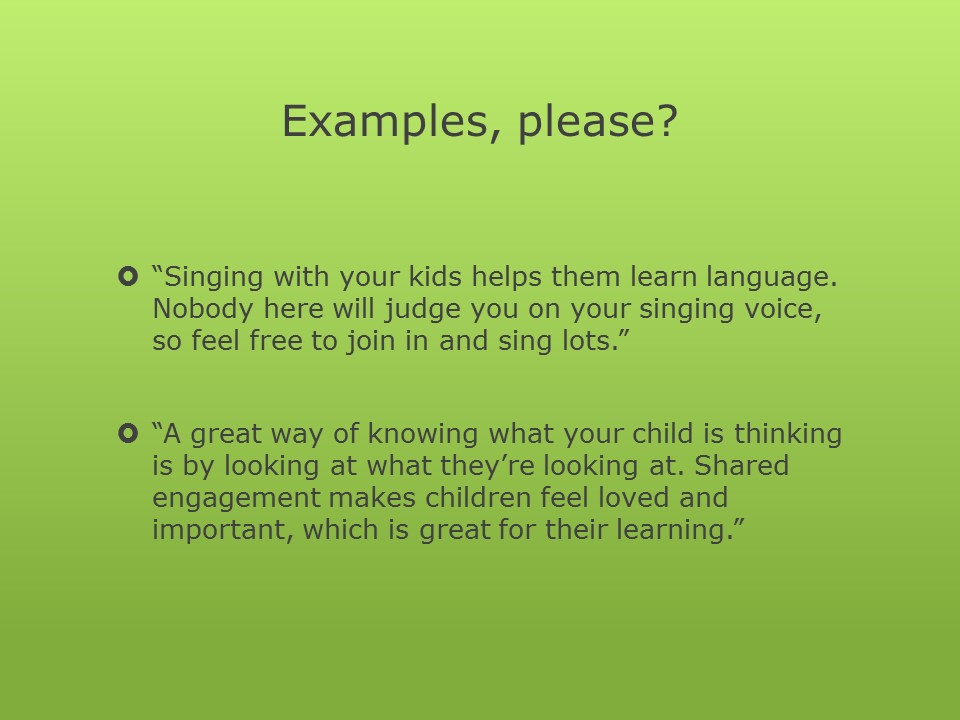
If you need to prod the caregivers a bit:
- "Singing with your kids helps them learn language. Nobody here will judge you on your singing voice, so feel free to join in and sing lots."
- "A good way of knowing what your child is thinking is by looking at what they're looking at. Shared engagement makes children feel loved and important, which is great for their learning."
Transition Times Are Great
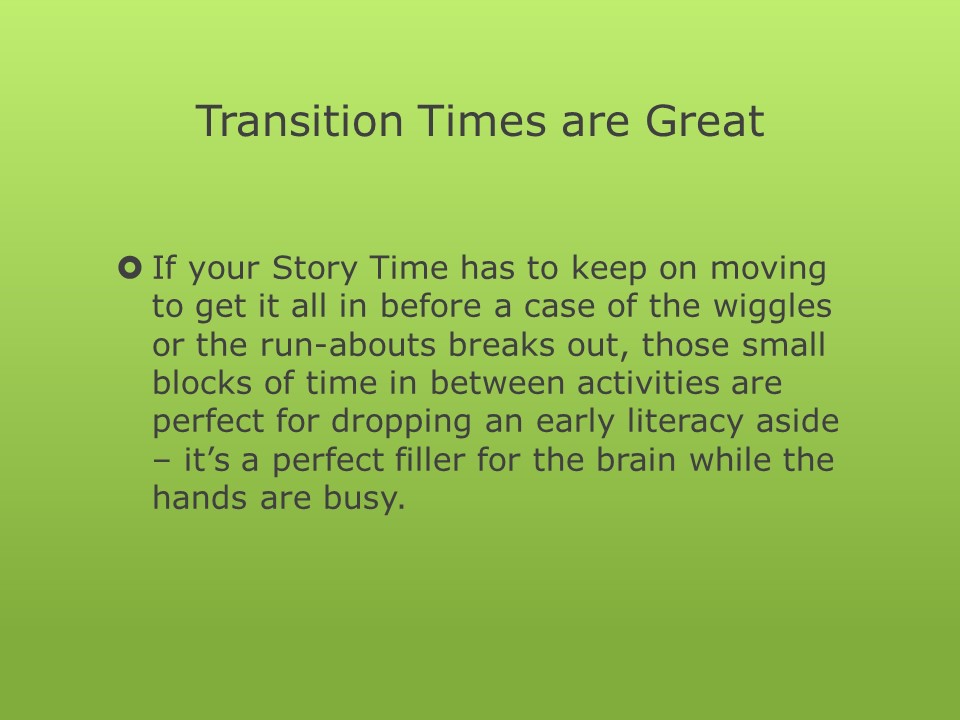
Transition Times - those bits and pieces that are in between activities in Story Times and programs - are just long enough to have an Early Literacy Aside put into them before you're ready to go again.
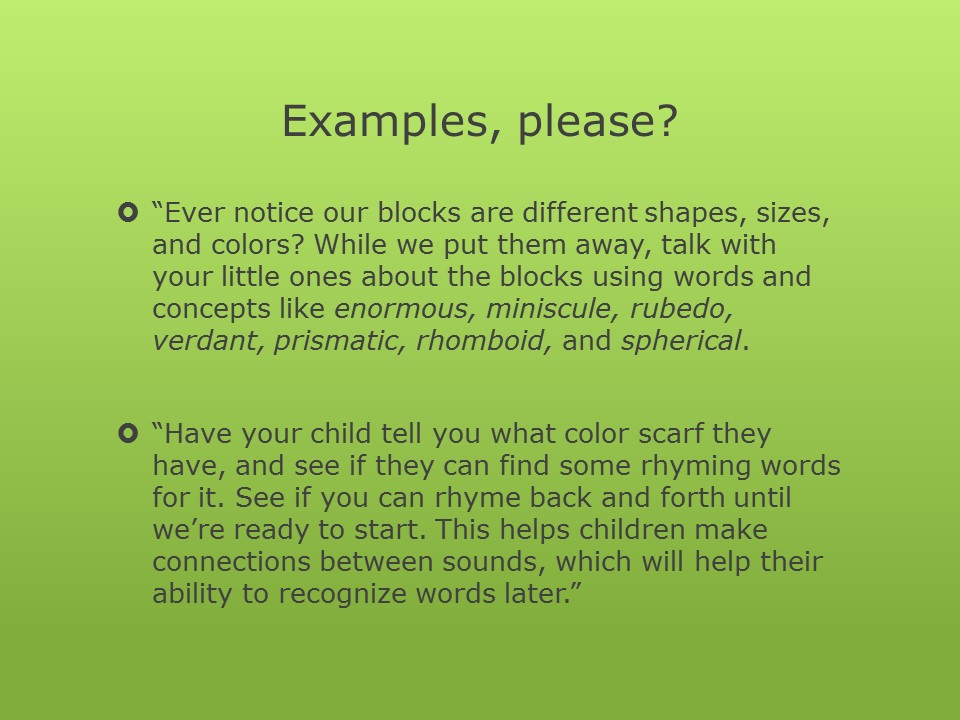
Here's a couple ways to get your transition times sparkling with early literacy asides:
- "Ever notice our blocks are different shapes, sizes, and colors? While we put them away, talk with your little ones about the blocks using words and concepts like enormous, miniscule, rubedo, verdant, prismatic, rhomboid, and spherical."
- "Have your child tell you what color scarf they have, and see if you can find some rhyming words for it. See if you can rhyme back and forth until we're ready to start. This helps children make connections between sounds, which will help their ability to recognize words, later."
Note Literacies at Work
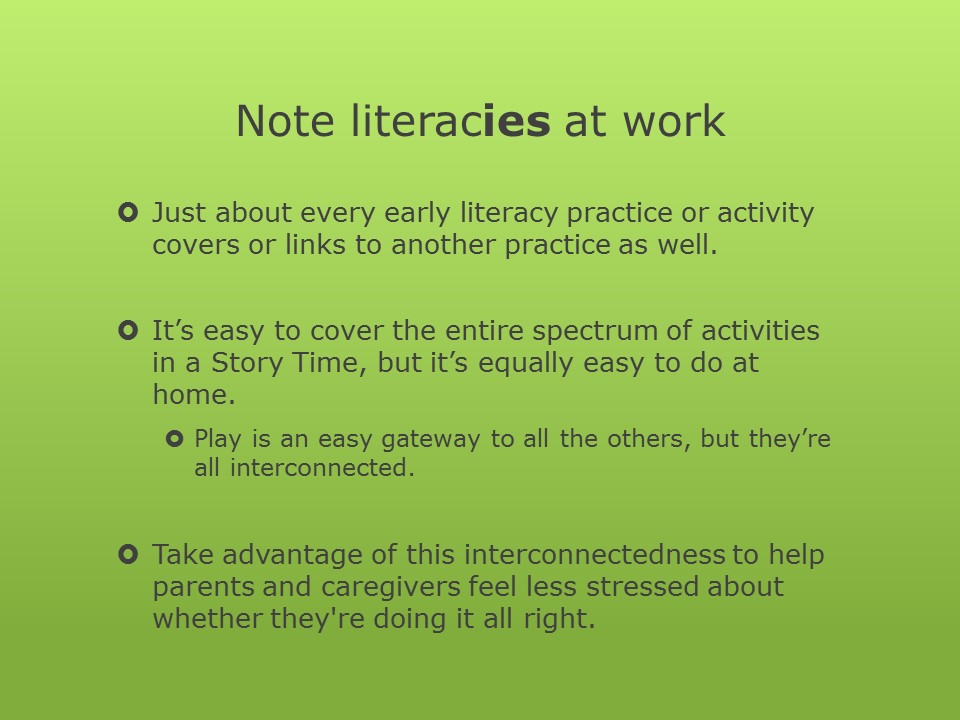
Here's a secret - most of the things that you do in youth programs and Story Times cover more than one of the five practices of early literacy. While it's easy to cover the entire spread in specific programs, caregivers may feel like if they're not doing the same, they're not doing well enough or helping at all.
It's worth pointing out that many of those things that do get done cover more than one of the practices by themselves. Play is sometimes the easiest gateway to all the other practices, but all five can link easily and seamlessly between each other. Foregrounding this may help make caregivers feel less anxious about making sure they do everything right.
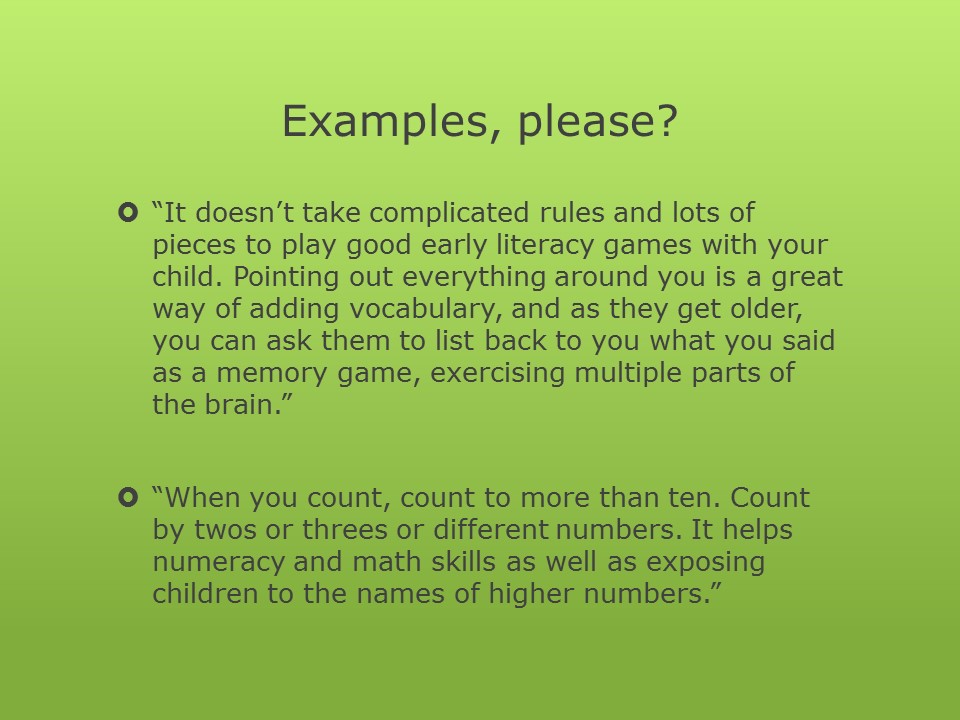
Here are some ways of helping caregivers feel better about their work:
- "It doesn't take complicated rules and lots of pieces to play good early literacy games with your child. Pointing out everything around you is a good way of adding vocabulary, and as they get older, you can ask them to list back to you what you said as a memory game, exercising multiple parts of the brain."
- "When you count, count to more than ten. Count by twos or threes or different numbers. It helps numeracy and math skills as well as exposing children to the names of higher numbers."
Provide Reminders
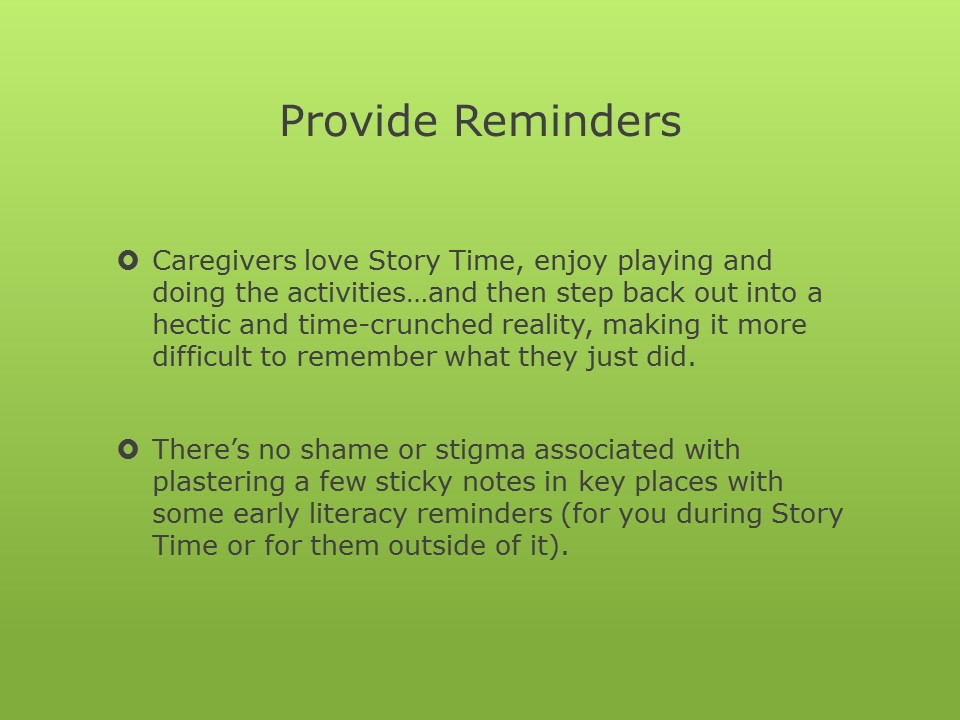
Unsurprisingly, there's a big world outside your library. And while it's easy to remember all the good practices from Story Time while in Story Time, outside, there's all the other pressures that impose cognitive load on them. It's easy to forget the good stuff just learned at the first thing that goes sideways.
The same thing goes for Youth Services people - so there's no shame in putting up a few reminders for ourselves to remember to do the things we think are cool and will be good for program attendees.
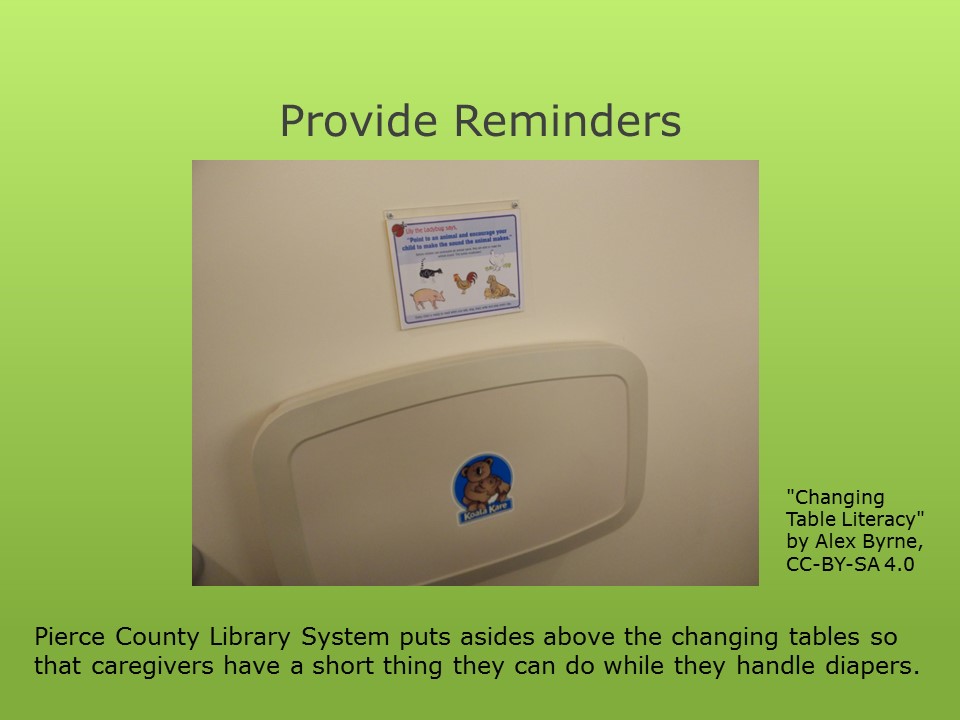
Pierce County Library System puts up their early literacy reminders above the changing tables in their bathrooms. There's going to be a caregiver, and a child, and at least a minute or two where there's going to be an interaction. Why not do something for early literacy while the hands are busy changing diapers? The Association of Library Services To Children has posters you can download and print for your own changing tables.
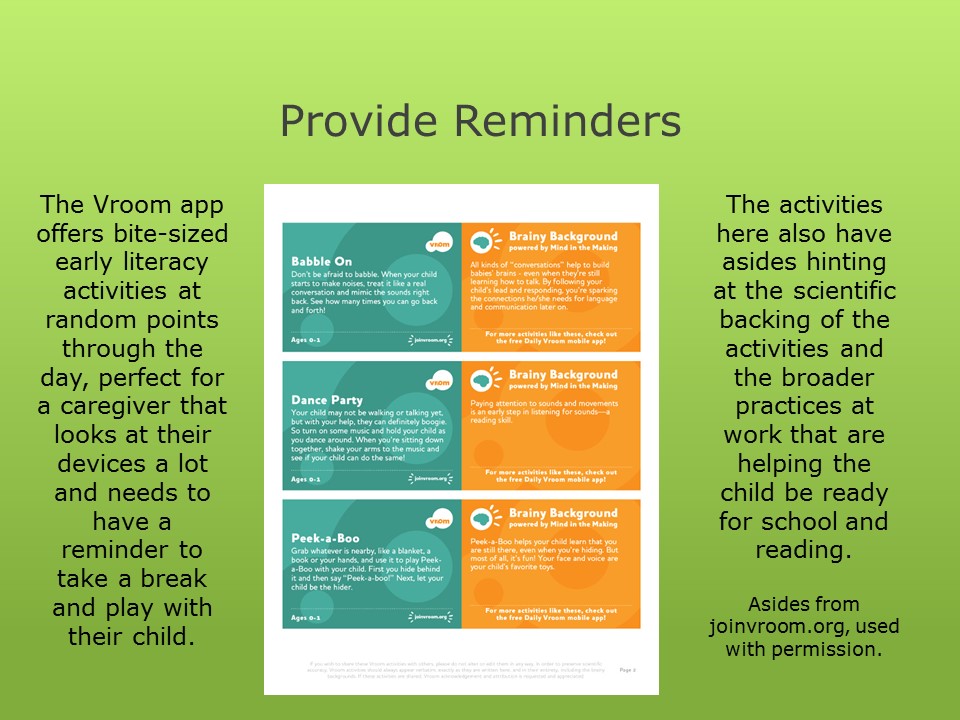
For parents with smartphones and tablets, Vroom is a free app that provides reminders and activities to do with children through the day, tailored for a specific age from birth to four years old. Vroom also offers their tips in print forms for those parents that don't have smartphones or don't want to download the app. They're great in that they have both the tip and a bit of the science behind the tip or further explorations to do after doing the tip.
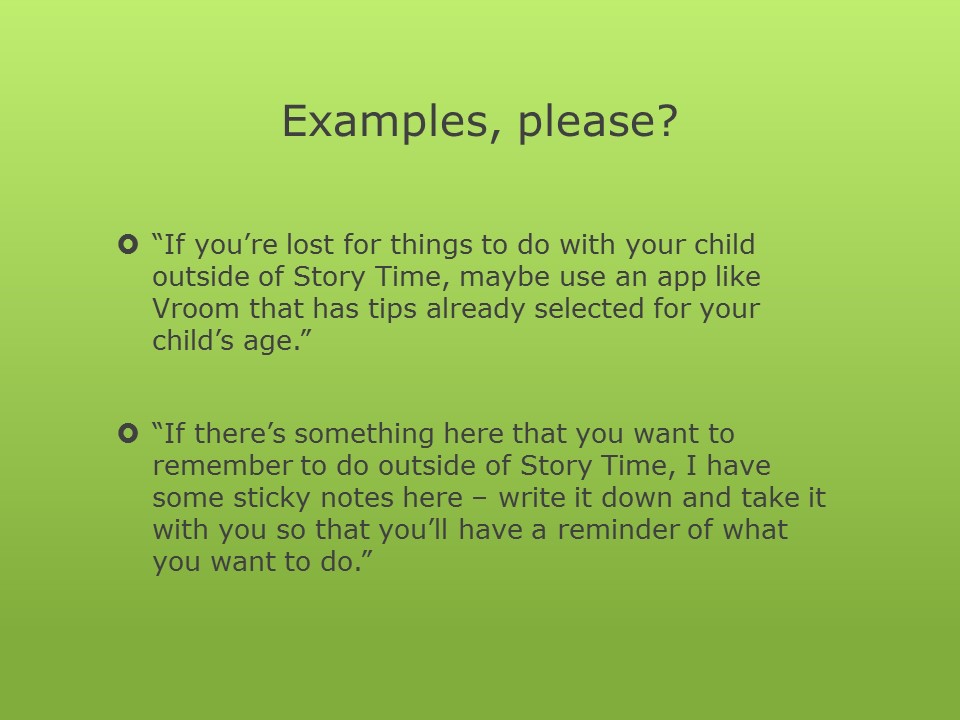
Have a couple reminders about reminders.
- "If you're lost for things to do with your child outside of Story Time, maybe use an app like Vroom that has tips already selected for your child's age."
- "If there's something you want to remember to do outside of Story Time, I have some sticky notes here - write it down and take it with you so that you'll have a reminder of what you want to do."